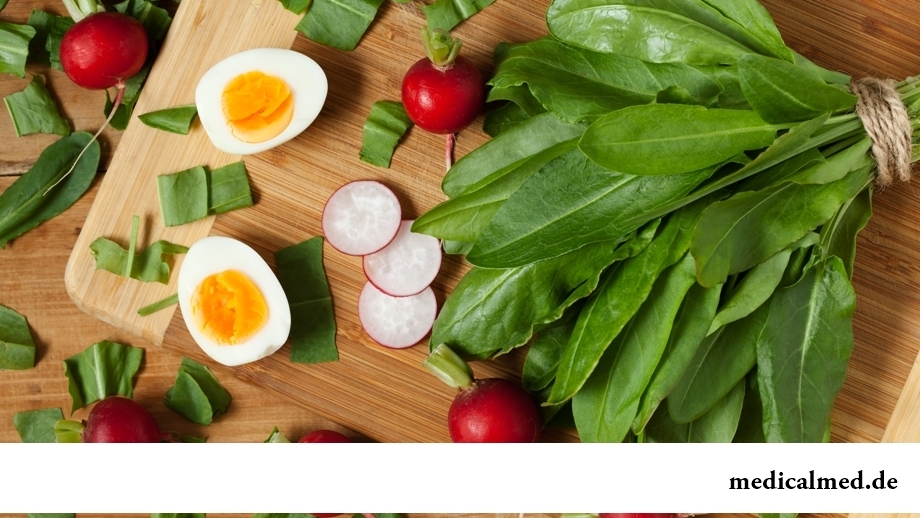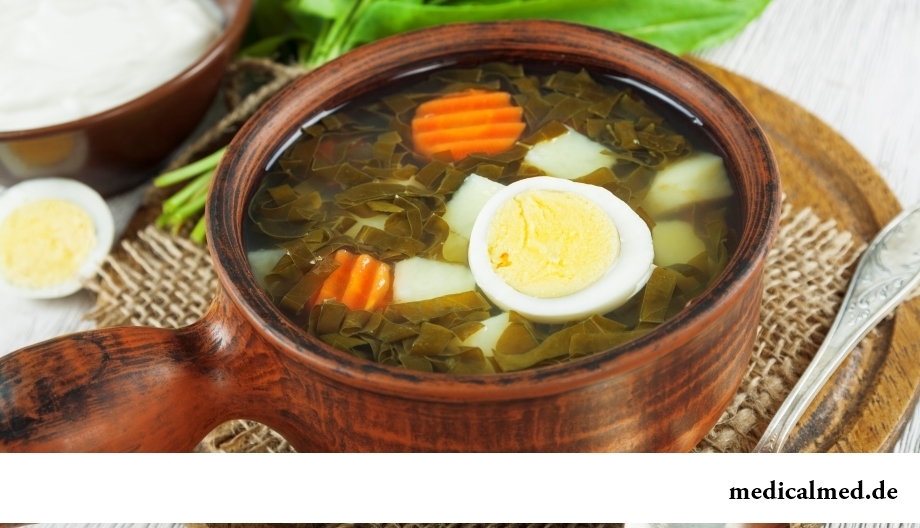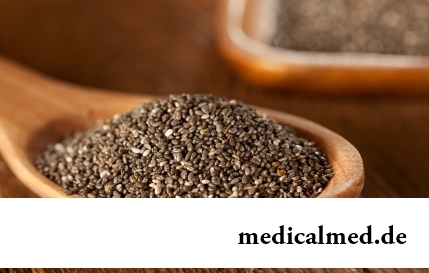





Sorrel
Sorrel – a perennial plant from family of the Buckwheat family. In Latin the sorrel is called as Rumex that is translated as "spear". In the people it is often called meadow apple or wild beet.

The plant has a direct stalk, sometimes rough and branchy. Leaves are petiolar, the large size, and flowers are collected in panicled inflorescences. In total there are about two hundred types of a sorrel from which only several types are considered medicinal and edible, and the majority are agrestal plants to this day. This vegetable culture in all continents, behind an exception grows unless, Antarctica.
History
History of cultivation of this plant originates on the several millennia ago. The first references of medicinal properties of a sorrel meet in Pliny the Elder and Virgil's works. Its medicinal properties in the treatise "Canon of Medical Science" were described also by Avicenna. He considered that broth from leaves of a sorrel reduces morbidity of periods, saves from infertility and softens the climax period.
For the first time as vegetable culture the sorrel was ranked by French in the 12th century. To this day this vegetable is considered at them national, as well as carrots. In medieval Europe people believed that the sorrel protects from plague. So, in ancient doctor books to properties of a sorrel attributed the help from heat and plague fever, clarification of urine and blood, treatment of diseases of a liver.
In Russia long time treated this vegetable as to a weed, and sneered at the foreigners eating this "a green grass". A bit later in Ancient Russia "wild beet" was used as charms and considered sacred, and also treated with its help rheumatic diseases and tuberculosis.
Sorrel in cookery
The sorrel was widely adopted in cookery. It is eaten in a fresh, marinated, dried or tinned look, added to soups, salads, borsches, sauces. Often it is used as a stuffing for pies.
In food young leaves of a sorrel which cut off before emergence of floriferous escapes are good. Old leaves are not recommended for the use as in them oxalic acid collects.
And to neutralize the small content of oxalic acid in young leaves of a plant, with a sorrel it is necessary to add milk or dairy products to a dish. Then oxalic acid reacts with calcium and turns into calcium salt, absolutely harmless to an organism.
Structure and caloric content of a sorrel
100 g of a sorrel contain 91,3 g of water, 2,4 g of carbohydrates, 2,3 g of proteins, 0,8 g of cellulose, 0,7 g of organic acids, 0,4 g of fats, 1,7 g of ashes; vitamins: beta carotene (A), thiamin (B1), Riboflavinum (B2), Niacinum (B3), pantothenic acid (B5), pyridoxine (B6), folic acid (B9), phylloquinone (K), ascorbic acid (C), biotin (N), tocopherol (E); macrocells: chlorine, phosphorus, potassium, sodium, magnesium, sulfur, calcium; microelements: fluorine, zinc, copper, manganese, iodine, iron.
Caloric content at a sorrel low also makes no more than 21 kcal on 100 g of a product.
Acid relish to a sorrel is impacted by the potassium salt of oxalic acid which is contained in leaves. Also leaves contain mineral salts, tannins, flavonoids. And roots of a plant contain about 27% of tannins, румицин, chrysophanic acid, хризофанеин, a flavonoid неподин and its glycoside – непозид.

Useful properties of a sorrel
The sorrel is a medicinal vitamin plant. The main advantage of a sorrel consists in digestion improvement, a bleeding stop, establishing work of a gall bladder and liver, ability to heal wounds. It is considered that it is useful at cardiovascular diseases, an anemia, at an itch and rash on skin and also as antiallergic means.
The advantage of a sorrel, in particular its leaves and fruits, consists in anesthetic and the knitting action. Leaves of a plant render anti-toxic, wound healing, antiscorbutic and antiinflammatory effect.
In traditional medicine widely apply powders and broths from roots of a sorrel horse which use at colitis, ponosa, hemocolites, coloenterites. At cold broth of a sorrel is also very effective.
Contraindications
Praising this plant and praising medical advantage of a sorrel to skies, you should not forget that concerning its use there are also some contraindications. So, in particular, it is impossible to use a sorrel during pregnancy, at gastritis with a hyperoxemia, inflammatory diseases of kidneys, stomach ulcer or a duodenum.
With care it is worth using a sorrel at advanced age as there is a risk of development of gout and osteoporosis.
Generally, it is necessary to remember and apply one very wise rule: everything is good moderately.
Four segments of dark chocolate contain about two hundred calories. So if you do not want to recover, better not to eat it is more than two segments in days.

The chia plant, or the Spanish sage, is from South America. The indigenous people of the continent since ancient times used in food it семена:...
Section: Articles about health
The medicine promptly develops, and the fact that else quite recently it seemed by miracle can now. We are not surprised any more to the fact that people with artificial joints and extremities can play sports, organ transplantation became a routine, and the latest cancer medicine п...
Section: Articles about health
Physical activity is necessary for normal functioning of a human body. At a lack of the movement joints cease to function, muscles atrophy, cardiovascular activity is broken and the metabolism worsens. The modern city rhythm of life does not provide the person with an adequate exercise stress, additional - sport is necessary. Tedious tasks the huge number of the people having those or ин exists sport not all to liking, but also...
Section: Articles about health
Many parents of children at the age of 2-4 years face excessively whimsical behavior of the child. The kid exhausts constant crying...
Section: Slideshow
From the failure of work of immune system which is shown in the form of an allergy, statistically, more than 40% of the population of the globe suffer. In most cases pathological reactions cause the substances which are contained in food stuffs, hair of animals, medicines...
Section: Articles about health
The sclera and mucous membrane of an eye are intensively supplied with blood vessels which problem - to saturate nervous tissues of body with nutrients and oxygen. In a normality vessels are almost not noticeable, however at their expansion (owing to thinning of walls) become visible, painting a sclera in red color. Quite often red eyes - the signal of any trouble in an organism caused as external irritants, allergens, and diseases which need in about...
Section: Articles about health
Dietary supplements (dietary supplements) for the last decades were so thoroughly included into our life that, apparently, it is already impossible on...
Section: Articles about health
It is known that the person for 80% consists of water which participates in all processes of an organism. The person loses liquid daily – as a result of sweating, breath, an urination, and its insufficient completion due to various reasons can bring to обезвожив...
Section: Articles about health
All of us, unfortunately, should face flu nearly an every year. It would seem, so frequent disease has to be studied already up and down, and each person, at least once to them had (and the number of such people in our country aims at 100%), has to know the basic rules of its treatment. However as shows experience of doctors, there is no it, and often people, self-confidently thinking what is known as it is necessary to be treated, make mistakes....
Section: Articles about health
Scientists have no unambiguous opinion on a proximate cause of emergence of a carcinoma cutaneum today. Are precisely established only фа...
Section: Articles about health
Helminthosis is one of the most widespread diseases. Statistically, any species of helminths infected every third inhabitant of the planet. Most of specialists even consider these data strongly underestimated: some uninvited "cohabitants" of N...
Section: Articles about health
The main role in development of a peptic ulcer of a stomach and duodenum the bacterium Helikobakter plays pilor. Activity and the strengthened reproduction of this microorganism lead to weakening of protection of mucous membranes and their erosive damage. Displays of an illness seriously reduce quality of life: patients regularly test attacks of severe pain, heartburn, nausea. On this background also psychoemotional malfunctions develop: a kidney-vetch, as a rule, shows an acrimony, ча...
Section: Articles about health
For the time being the perspective of heart diseases seems to most of people remote and foggy. But sooner or later practically each adult faces extremely unpleasant feelings: sudden stethalgia. To be consoled at this time in a thought of what for a heart attack still early, will hardly turn out: if the person is impressionable, he, as a rule, has feeling of panic and fear of fast death. And meanwhile, it is very often possible to confuse pains with cardiac pains невралгическог...
Section: Articles about health
All the known slogan "Protect Men!" arose not from scratch. In a sense, the nature created representatives of strong...
Section: Articles about health
Musicotherapy – a treatment method which caused and causes a set of a controversy concerning its efficiency. However the facts are relentless: during the numerous researches curative impact of music on an organism was scientifically confirmed. Since then in a number of the countries a method...
Section: Articles about health
Cold – a state known to everyone which is followed by cold, cough, high temperature, a pharyngalgia. Often the first that we begin to do in hope again to become healthy – to accept medicines which are not always harmless whereas it is easy to facilitate displays of a disease by means of natural means. They not only softly eliminate disease symptoms, but also enrich the weakened organism with useful substances. We present you 8 drinks which are successfully used for...
Section: Articles about health
Work of a brain is extremely complex and in many respects is not studied yet. It is confirmed also by the features of thought processes which are shown in...
Section: Articles about health
Stability of a hormonal background is one of the most important conditions of preservation of health of the woman. At the same time endocrine system – the thin device extremely sensitive to any external influences. Changes of an image жиз can become the reason of hormonal failure...
Section: Articles about health
Popular joke that there are no healthy people, and is nedoobsledovanny, most of us considers an honest truth, continually it is necessary to hear that all of us are sick hardly from a school bench. It is hard to say whether so it actually because too often people are treated for nonexistent diseases, and sometimes call a disease what is something another. Sometimes in it the doctors of old school making diagnoses which are cancelled long ago – medicine still unless are guilty...
Section: Articles about health
Cold is such painful that each sigh becomes a victory, heat "knocks" down, and the ache in joints forces to think only about...
Section: Articles about health
Doctors claim that the people not so familiar with a dorsodynia occur among adult Russians very seldom. At the same time the vast majority of the patients who are periodically testing this indisposition do not hurry to ask for medical care at all. With one St...
Section: Articles about health
Some people consider what for medicine of the 21st century of secrets in the field of health of the person almost does not exist. It absolutely not so. The more answers scientists receive, the more the most difficult questions are raised for them by life. Besides, there are diseases which are not explained with science in any way of which existence people know for 100-150 years. These diseases meet not so often, but from some of them nobody is insured....
Section: Articles about health
Stroke (acute disorder of cerebral circulation) – one of the most widespread neurologic diseases. Annually in the world...
Section: Articles about health
Several decades ago the basil (the district khan, реан, Reagan) was considered as a part of the Caucasian or east cuisine, but today it strongly took the place on tables of Russians. Greens of this plant possess a strong, pleasant smell and specific fresh taste, because of to...
Section: Articles about health
Contrary to popular belief, the multiple sclerosis (MS) is not connected neither with sclerous changes of walls of vessels, nor with age forgetfulness and problems with concentration of attention. This disease has the autoimmune nature. Pathological process is expressed in degradation of nervous tissue and destruction of its enveloping layer - a myelin. Multiple damages of the central nervous system which are shown by decrease in sight, bystry fatigue, on become result of development of an illness...
Section: Articles about health


